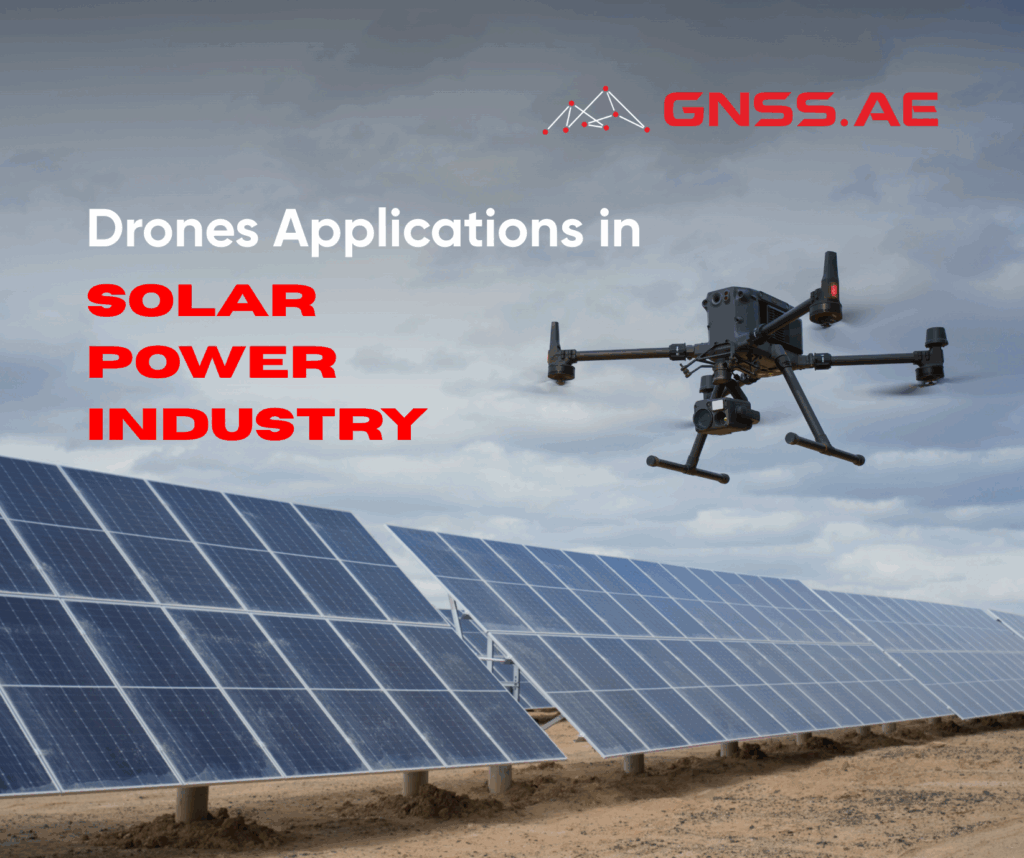
By: Dr. Amin Abd Elraheem (Ph.D., Training Manager)
As the global shift toward renewable energy accelerates, the solar industry faces growing pressure to enhance efficiency, reduce operational costs, and maintain environmental sustainability across increasingly large and complex installations. One of the most transformative technologies enabling this evolution is the use of unmanned aerial vehicles, commonly known as drones. Drone technologies have been increasingly used in electric power systems inspection, and have now become integral to nearly every phase of a solar farm’s lifecycle, from early-stage planning to ongoing maintenance and monitoring.
Drone Solar Inspection Market size was estimated as USD 1.2 Billion in 2024, predicted to reach a value of USD 2.3 billion by 2026, and is expected to witness a compound annual growth rate (CAGR) of approximately 15.2% from 2026 to 2033, reaching USD 3.8 Billion, as reported by Verified Market Reports.
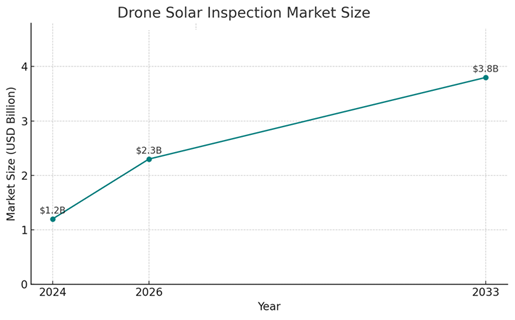
By leveraging advanced imaging technologies, automation, and artificial intelligence, drones offer unparalleled capabilities that streamline solar operations. They enable rapid and accurate site surveys, improve construction oversight, accelerate inspection processes, and even support innovative cleaning systems, all while minimizing the need for manual labor and enhancing safety. Furthermore, their role extends these engineering functions to include applications such as asset management, security surveillance, and environmental monitoring.
This article explores the various ways in which drones support the solar industry. It highlights their contributions across key areas, and shows how drone technology is not just complementing but actively reshaping the future of solar energy infrastructure.
According to P Market Research, utility-scale solar farms account for approximately 65% of the global demand for drone-based solar inspections. These installations typically exceed the capacity of 20 MW, and, due to their size, they require frequent and large-scale inspections. For example, Topaz Solar Farm in California uses drone inspections quarterly a year to inspect its 9 million solar modules. Drone systems can inspect such large Solar Farm in 3–5 days, whereas manual inspections could take weeks.
The second largest category is the Commercial and Industrial solar installations, which represents 25-30% of the market demand. These projects typically range from 500 kW to 10 MW, and are often installed on complex terrains; thus, drones are advantageous in such cases.
Moreover, the growth of the solar energy sector has prompted the implementation of new regulatory frameworks. For instance, Saudi Arabia’s Renewable Energy Initiative 2030 requires the use of drone-based quality inspections for solar installations larger than 5 MW.
The following sections outline the key application areas of drones in solar energy operations, highlighting the technology’s diverse capabilities and measurable benefits.
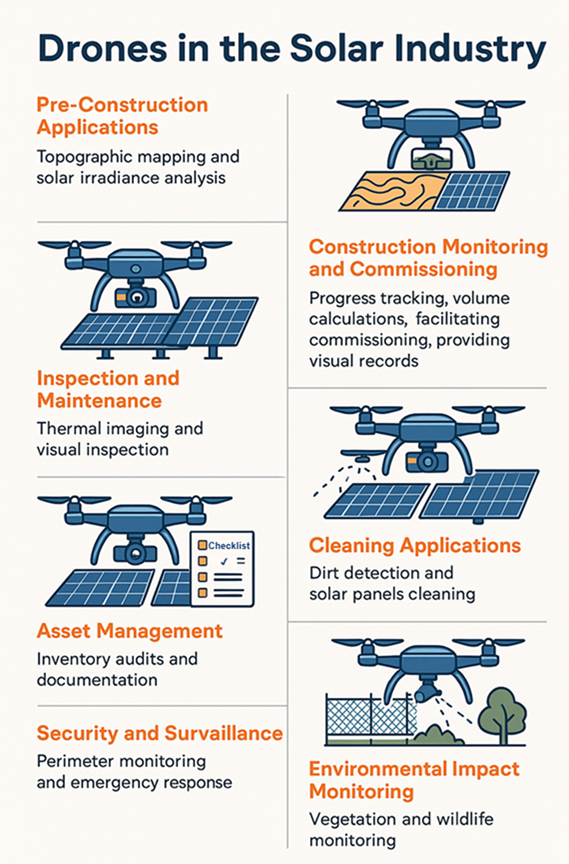
Drones support the solar industry in the following key areas:
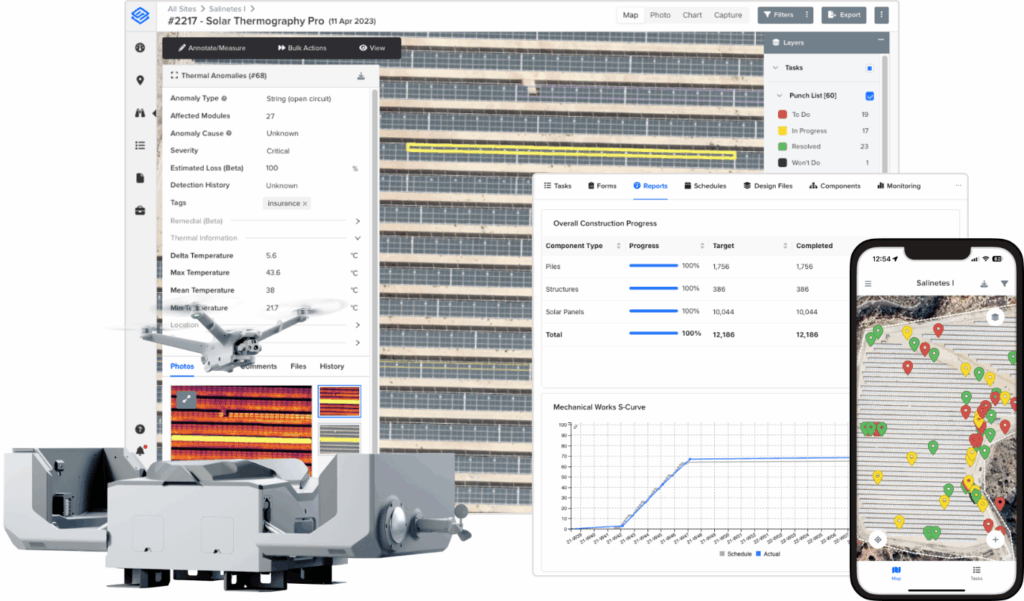
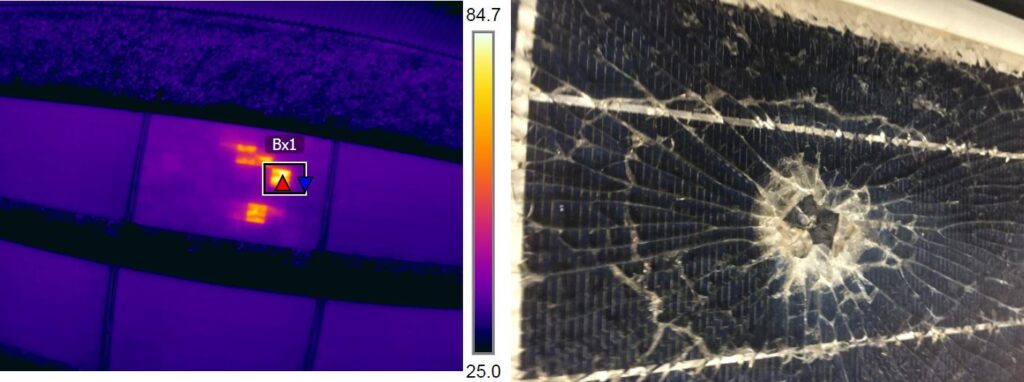
This data can be analyzed using AI and machine learning to identify faults, predict maintenance needs, prioritize repairs, and optimize energy production. As a result, drones can inspect large solar farms 400% faster than traditional methods, improving efficiency and cost-effectiveness.
As solar farms grow in size and complexity, data-driven solutions have become essential to maintaining performance, optimizing operations, and reducing downtime. In this context, some companies are improving the drone-based solar inspections by transforming them into highly intelligent and scalable workflows. For example, Sitemark’s platform combines high-resolution drone imagery—both thermal and visual—with advanced AI analytics to deliver actionable insights. Their cloud-based solution enables operators to detect anomalies, estimate energy losses, and prioritize maintenance tasks efficiently across large portfolios.
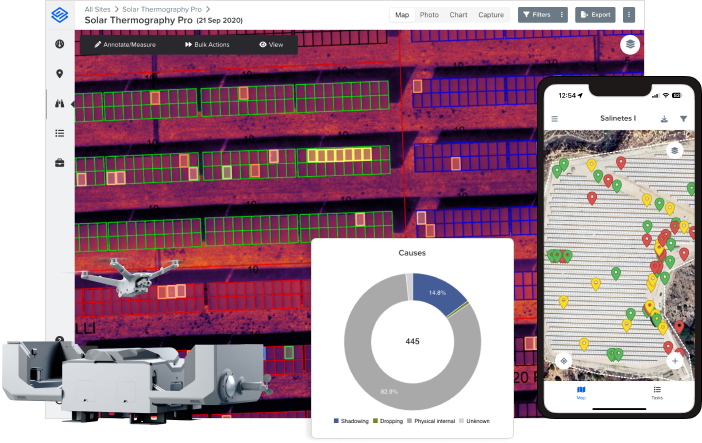
Moreover, drones can be used for inspecting the transmission lines, which transmit the generated solar power from the solar farms. For more information about the drone-based inspection for power lines and grids infrastructure, the reader may have a look at our previous article.
Panel efficiency can drop by 20–50% due to dust and dirt accumulation. Drone-based cleaning solutions now offer:

Such application would be quite useful and feasible in hard-to-access locations or in large and remote solar farms.
As solar farms continue to scale in size and complexity, drone technology offers expanded applications beyond immediate engineering and maintenance tasks. In addition to their critical roles in pre-construction analysis, construction monitoring, inspection, and cleaning, drones also play a pivotal role in supporting the broader operational, security, and environmental needs of solar energy infrastructure.
By integrating these additional applications, drones not only optimize the performance and safety of solar energy systems but also contribute to their long-term viability and sustainability.
The table below highlights the key benefits of using drones in the solar power industry. It lists the advantages such as efficiency, cost savings, accuracy, and safety, quantifying them with relevant metrics. These insights demonstrate why drone-based inspections are becoming a standard practice for maintaining and optimizing solar power plants:
| Advantages | Specific Benefits | Details |
|---|---|---|
| Efficiency & Speed | Faster inspection cycles | Drone systems can inspect large-scale solar farms 70–90% faster than manual methods |
| Real-time data acquisition | Enables rapid diagnostics and reporting | |
| Cost Reduction | Lower labor and operational costs | Drones reduce inspection costs by up to 40% |
| Minimized downtime | Early fault detection prevents up to 30% in energy loss | |
| Accuracy & Diagnostics | High-resolution fault detection | Thermal/multispectral imaging achieves 95% accuracy |
| Detailed analysis of panel defects | Identifies hotspots, cracks, shading, and string mismatches | |
| Safety | Reduced risk for human inspectors | Avoids exposure to heat, electrical hazards, and unsafe terrain |
| Predictive Maintenance | Data-driven operations and early intervention | Automated drone systems using machine learning algorithms can predict maintenance needs with 89% accuracy, reducing unplanned downtime by up to 30% |
| Environmental Impact | Lower carbon footprint of maintenance operations | Fewer on-site vehicles and reduced manual activity support sustainability |
| Regulatory Compliance | Simplified documentation and reporting | Geo-tagged data supports audit trails, warranty claims, and insurance reports |
The Middle East and North Africa (MENA) region is rapidly emerging as a global hub for solar energy development, driven by abundant solar resources, growing energy demands, and strategic national initiatives aimed at diversifying energy portfolios. With some of the highest solar irradiance levels in the world—receiving between 2,000 and 2,300 kWh/m² annually in many areas—the region is exceptionally well-positioned to capitalize on solar power as a basis of its renewable energy strategy.
Countries across the MENA region are setting ambitious renewable energy targets as part of broader efforts to reduce reliance on fossil fuels and lower carbon emissions. For instance, the UAE aims to generate 44% of its energy from clean sources by 2050, with significant investments in solar projects like the 5,000 MW Mohammed bin Rashid Al Maktoum Solar Park. Similarly, Saudi Arabia’s Vision 2030 outlines a goal of installing 58.7 GW of renewable capacity by 2030, of which solar power constitutes a major share. Egypt, Jordan, and Morocco are also pushing ahead with large-scale solar developments to meet rising electricity demand and reduce import dependency.
As the MENA region accelerates the deployment of large-scale solar projects to meet its ambitious energy goals, efficient management and maintenance of these expansive installations have become increasingly critical. This has led to the growing integration of advanced technologies, such as energy storage systems, AI-based grid management, and drone systems to enhance the efficiency and scalability of solar infrastructure. Drones, in particular, are being widely adopted for surveying, construction monitoring, and inspections.
The following case studies highlight how drones are being utilized across major solar projects in the MENA region:

One of the newest large-scale solar power projects in the region. Upon its completion in June 2023, Al Dhafra was the world’s largest single-site solar plant, using almost 4 million bifacial solar panels with a capacity of 2 GW. It generates enough electricity for approximately 200,000 homes across the UAE, displacing 2.4 million tonnes of carbon emissions annually.
Of course, in a project with such a scale, the use of advanced technologies is crucial to maintain efficient operation:
These case studies underscore the transformative impact of drone technology on solar power operations in the MENA region, demonstrating significant improvements in monitoring, inspection efficiency, and overall plant performance.
Drones are playing an increasingly central role in the solar power industry, offering a versatile, data-driven approach to managing the lifecycle of solar energy systems. As detailed throughout this article, drone applications now extend well beyond inspection, encompassing pre-construction surveying, construction progress tracking, thermal diagnostics, automated cleaning, asset management, and environmental monitoring.
These technologies address some of the most pressing challenges facing the solar sector today, namely, the need for greater efficiency, accuracy, and scalability in operations. Drones can inspect solar farms up to 90% faster than manual methods, reduce operational costs by as much as 40%, and identify faults with over 95% accuracy, making them essential for maintaining performance in large and distributed installations.
With the global solar market expanding rapidly and new regulatory standards emerging, the integration of drones is not just enhancing technical workflows but becoming foundational to meeting future energy demands. As demonstrated by examples from utility-scale and commercial solar projects alike, drones are transforming how solar power systems are planned, built, maintained, and sustained, making them a key enabler of the industry’s continued growth and resilience.